The History
The History
Grace Church at Rector Street
Seeking to expand the Episcopal tradition, Grace Church was conceived in 1801 by the Rector and Vestrymen of Trinity Church. Land was purchased at the corner of Broadway and Rector street, the previous site of a Lutheran Church destroyed in the Great Fire of New York in 1776. The lot was purchased for $21,150, and eight years of construction cost $82,291.
The modest original structure was completed in 1809 and was reported on by The Churchman’s Magazine that January: “The edifice forms a parallelogram of 101 feet… and 57 feet in width. Composed principally of brick.” The circular cupola on the roof is made up of “columns of the Ionic order” supporting “the dome roof, form which springs a small fanciful spire.” The newly finished interior contained “a lofty concave ceiling…supported by four massy columns in the Grecian Ionic order” The mahogany furniture and sensible stone stairs presented “one of the most beautiful Chancels in the United States” at that time.
In 1842 the Vestry of Grace Church began to deliberate about the relocation of the Church uptown. Surveys of the congregation discovered that 95 families that had previously leased pews had declined to renew their rentals, or were traveling from above Canal Street to attend service. With waning attendance, and the imminent completion of the new Trinity Church building, the decision to move Grace Church North was made in 1845. The site of the new Church was purchased mainly from Henry Breeveport and with money borrowed against the original structure at Rector Street. While some members were apprehensive about the church moving so far above the concentration of mid 19th century population centers, the site was purchased July 1st, 1845.

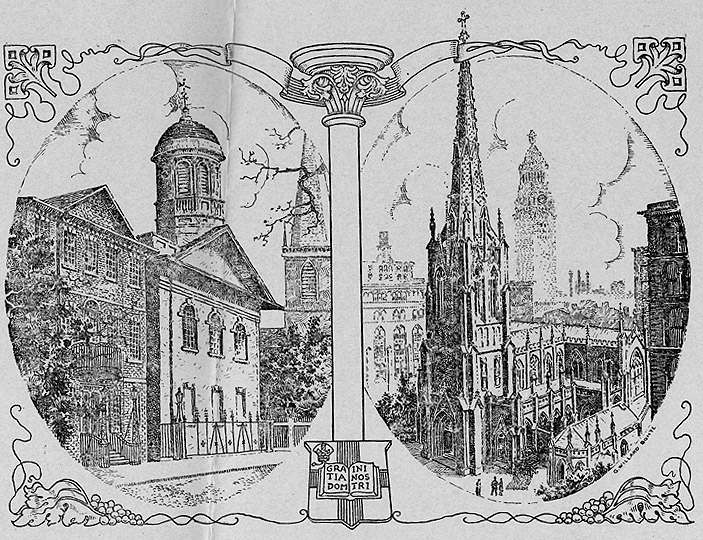

Grace Church at Rector Street
Seeking to expand the Episcopal tradition, Grace Church was conceived in 1801 by the Rector and Vestrymen of Trinity Church. Land was purchased at the corner of Broadway and Rector street, the previous site of a Lutheran Church destroyed in the Great Fire of New York in 1776. The lot was purchased for $21,150, and eight years of construction cost $82,291.
The modest original structure was completed in 1809 and was reported on by The Churchman’s Magazine that January: “The edifice forms a parallelogram of 101 feet… and 57 feet in width. Composed principally of brick.” The circular cupola on the roof is made up of “columns of the Ionic order” supporting “the dome roof, from which springs a small fanciful spire.” The newly finished interior contained “a lofty concave ceiling…supported by four massy columns in the Grecian Ionic order” The mahogany furniture and sensible stone stairs presented “one of the most beautiful Chancels in the United States” at that time.
In 1842 the Vestry of Grace Church began to deliberate about the relocation of the Church uptown. Surveys of the congregation discovered that 95 families that had previously leased pews had declined to renew their rentals, or were traveling from above Canal Street to attend service. With waning attendance, and the imminent completion of the new Trinity Church building, the decision to move Grace Church North was made in 1845. The site of the new Church was purchased mainly from Henry Breeveport and with money borrowed against the original structure at Rector Street. While some members were apprehensive about the church moving so far above the concentration of mid 19th century population centers, the site was purchased July 1st, 1845.

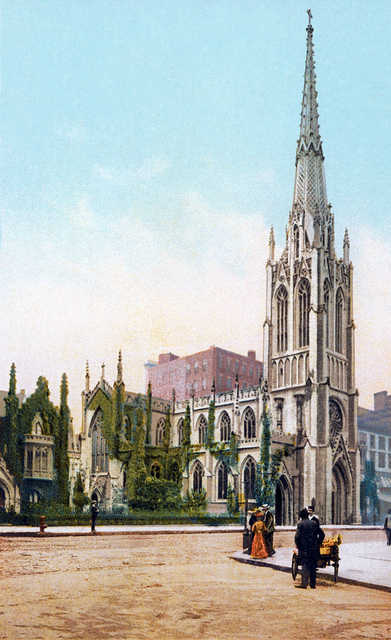
Grace Church and Rectory 1850’s
Grace Church at Broadway
With the new site in mind at Broadway and 10th St, the Building Committee set to work finding an architect for the new church. The contract contest was won in 1843 by James Renwick Jr. Despite being son to an architect and professor of Columbia University, Renwick was not formally trained in architecture. His graduation from engineering studies at Columbia was followed by several years of work at the Erie Railroad Company, punctuated by frequent cultural tourism in Europe. While traveling, he studied the great Cathedrals of France, and became acquainted with the Ruskinian Gothic Style which came into fashion in the mid 1840’s.
After settling negotiations with various Greenwich Village landowners, and fending off minor friction with the city government, the cornerstone of Grace Church was laid October 30th, 1843. The construction in Henry Breeveport’s former apple orchard continued, and was projected to last for two years. The primary material chosen was white marble, as Renwick believed it combined “durability, beauty, and economy” The marble would be quarried by Sing Sing State Prison in Ossinging, New York. The same quarry would supply materials for New York University, The New York State Capitol Building, and The United States Treasury Building.
Interruptions in material supplies and the sudden death of a chief Stonemason delayed the project, but Renwick’s church would be completed and consecrated on March 7th, 1846. Period newspapers recorded the impressive nature of New York’s earliest Gothic Revival church. The Herald described the “lofty tower” “octagon spire” and “deep buttresses” as “one of the most splendid buildings in the City.” The Tribune reported the consecratory service bathed in “colored light…made the coup d’oeil rich in the extreme.”
New York City’s earliest example of Gothic Revival architecture, Grace Church has been a steadfast fixture in Greenwich Village since its consecration on March 7, 1846. Designed by famed architect James Renwick, Jr., Grace is a cultural icon, a clear embodiment of the style and elegance of a past time

Grace Church at Broadway
With the new site in mind at Broadway and 10th St, the Building Committee set to work finding an architect for the new church. The contract contest was won in 1843 by James Renwick Jr. Despite being son to an architect and professor of Columbia University, Renwick was not formally trained in architecture. His graduation from engineering studies at Columbia was followed by several years of work at the Erie Railroad Company, punctuated by frequent cultural tourism in Europe. While traveling, he studied the great Cathedrals of France, and became acquainted with the Ruskinian Gothic Style which came into fashion in the mid 1840’s.
After settling negotiations with various Greenwich Village landowners, and fending off minor friction with the city government, the cornerstone of Grace Church was laid October 30th, 1843. The construction in Henry Breeveport’s former apple orchard continued, and was projected to last for two years. The primary material chosen was white marble, as Renwick believed it combined “durability, beauty, and economy” The marble would be quarried by Sing Sing State Prison in Ossinging, New York. The same quarry would supply materials for New York University, The New York State Capitol Building, and The United States Treasury Building.
Interruptions in material supplies and the sudden death of a chief Stonemason delayed the project, but Renwick’s church would be completed and consecrated on March 7th, 1846. Period newspapers recorded the impressive nature of New York’s earliest Gothic Revival church. The Herald described the “lofty tower” “octagon spire” and “deep buttresses” as “one of the most splendid buildings in the City.” The Tribune reported the consecratory service bathed in “colored light…made the coup d’oeil rich in the extreme.”
New York City’s earliest example of Gothic Revival architecture, Grace Church has been a steadfast fixture in Greenwich Village since its consecration on March 7, 1846. Designed by famed architect James Renwick, Jr., Grace is a cultural icon, a clear embodiment of the style and elegance of a past time
The Rectory
After the completion of Grace Church in 1846, James Renwick Jr. was once again commissioned to design a residence for the Rector of Grace. Using the same white marble, and in a similar 15th Century English Gothic style, the Rectory was completed in 1847. The four story residence contains a dining room, a study for the Rector, a reception room, as well as bedrooms for the Rector and family. The interior hallways and banisters are decorated with Gothic mullions, keeping in theme with the Gothic facade. The building was renovated in 1922 to restore the interior and adhere to building standards.
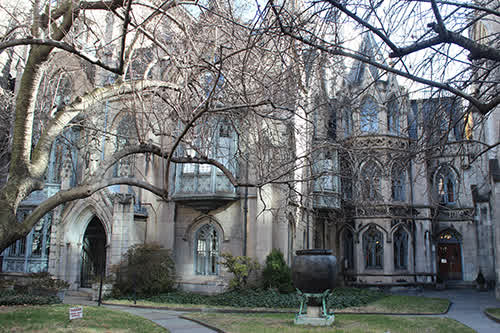

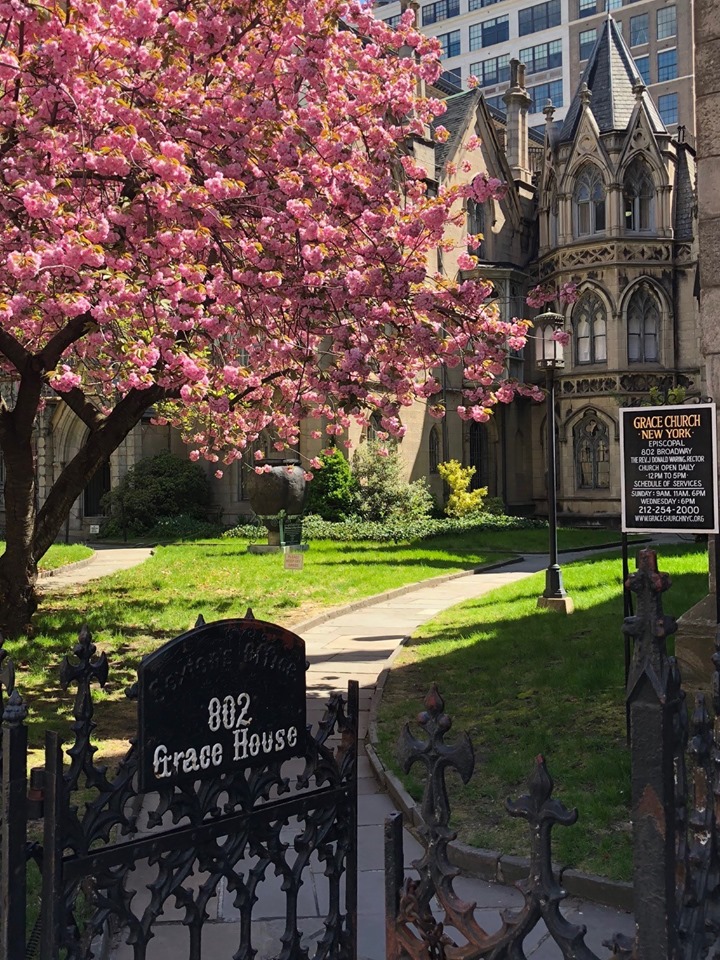
Grace House
The Grace House was built in the space between the Rectory and Church in 1881. In the same style as the Rectory frontage, Grace House is set back 20 feet and connects the interiors of the neighboring structures. Its original construction featured a large Vestry room adjoined with the Rector’s study, as well as a library sheltering 3000 books. The Sacristy, built into the angle of the north transept, houses the vestments and vessels for sacrament. Though other parts of the first floor have been restructured, the Sacristy’s historic art and vaulted ceiling have remained since their completion in 1922.
Huntington Close and The Chantry
In 1905, the Vestry of Grace Church purchased the property South of the Church and North of 10th Street. The former site of the Vienna Bakery, the five story building was demolished to create a closed garden. The Vestry of Grace Church borrowed $375,000 for the purchase, which was paid back the following year by a fundraising effort observing the 100th anniversary of the Church’s consecration. When Rector Huntington died in July of 1909, the green space was dedicated in his name.
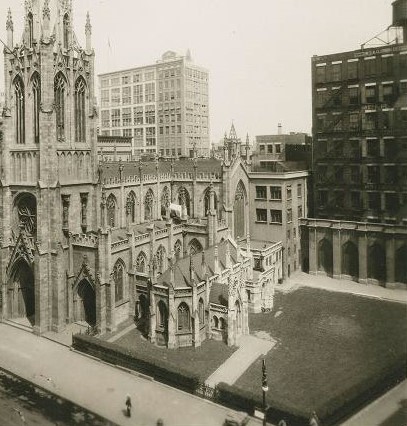
Saving Grace NYC
802 Broadway
New York, NY 10003
212-254-2000
Contact Us
